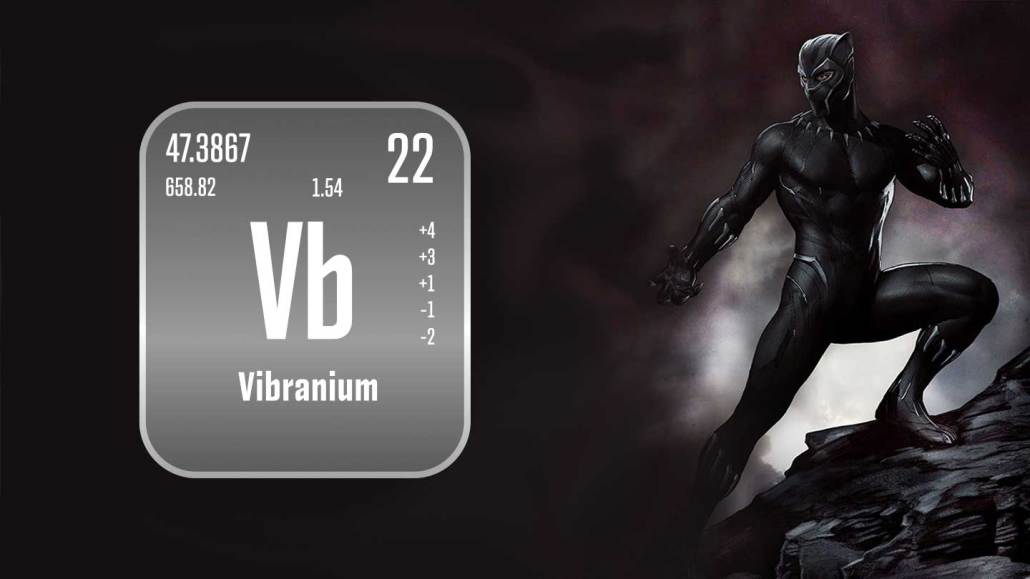Could we make vibranium?
The ‘perfect’ metal may be fictitious, but scientists hope we can mimic some of its key traits

The Black Panther's superpowers stem from a mystical herb, but they get help from a supersuit woven with vibranium. Chemists dreamt up what that fictional element might look like on the periodic table.
BLACK PANTHER: 7E ART/MARVEL STUDIOS/WALT DISNEY PICTURES/PHOTO 12/ALAMY STOCK PHOTO; VIBRANIUM ILLUSTRATION: STEVE MCCRACKEN
Share this:
- Share via email (Opens in new window) Email
- Click to share on Facebook (Opens in new window) Facebook
- Click to share on X (Opens in new window) X
- Click to share on Pinterest (Opens in new window) Pinterest
- Click to share on Reddit (Opens in new window) Reddit
- Share to Google Classroom (Opens in new window) Google Classroom
- Click to print (Opens in new window) Print
By Anil Oza
In the fictional Marvel universe, an element called vibranium can do many things. The fantastical metal makes up Captain America’s near-impenetrable shield. It gives Black Panther superpowers. It also helps the futuristic African society of Wakanda run. There are shiny, metallic skyscrapers with blue neon lights. Flying vehicles that can shoot lasers. Video calls with 3-D holograms.
And all of this is due to that near-magical substance. A meteorite brought it to Wakanda long ago.
No one has discovered vibranium on Earth, of course. And scientists say that finding something similar is a long shot. However, mimicking some of the fabulous substance’s superpowers might be a possibility.
What is vibranium?
Vibranium’s key traits line up with our definition of metals, says Darryl Boyd. He’s a chemist at the U.S. Naval Research Laboratory in Washington D.C. And as a Black Panther fan, Boyd has thought a lot about vibranium. Metals, he notes, should be able to conduct heat and electricity. They also should be shiny and able to be molded into sheets or pulled into wires.
“You can argue that you see all five [of those traits] throughout the various Marvel representations of vibranium,” Boyd says. But the three that stick out to him are vibranium’s strength, conductivity and luster.
In Wakanda, people use vibranium in medicine, electrical circuitry, fabrics, jewelry, communications and more. “The city transportation system runs by vibranium. And that implies pretty heavily that there’s some kind of conductive nature,” Boyd says. “So this, again, is consistent with what we know about the properties of metals.”
It also looks shiny, bright and very regal. This is similar to other metals that can shine in brilliant colors, such as gold and silver.
What is the closest thing we have to vibranium?
“There’s no perfect element” — at least on Earth, notes Sibrina Collins. She’s a chemist at the Marburger STEM Center at Lawrence Technological University in Southfield, Mich. But Wakanda’s vibranium “seems to be the perfect element,” she says. In that land, it “can be used for absolutely everything.” In fact, she notes, it “has aspects of various elements on a periodic table.” In other words, there may not be one substitute for vibranium. But many elements, combined, might fit the bill.
For instance, Boyd says, like titanium, vibranium is strong. It’s also got the shine of silver or platinum and the electrical conductivity of copper. He concludes that vibranium “represents [a mashup] of the best properties of the metals that we know of.”
Collins also compares vibranium to platinum because of its use as medicine in Black Panther. Platinum may not be the cure-all that vibranium is. But it is a part of some drugs used to treat cancer, such as cisplatin.
If vibranium were real, where would it go on the periodic table?
Having traits of so many metals makes it difficult to pin down where vibranium could go on the periodic table of elements. Collins suggests it would be in what’s known as its D or F blocks. These elements appear in the table’s middle and very bottom. Collins notes this is also where we find many of the metals that go into computers and other tech.
The periodic table typically groups elements with similar properties. If Boyd were to add vibranium to the table, he’d create another row and place it under uranium and neodymium.
“Neodymium is used in magnets,” he points out. “It’s in almost all your computers.” In fact, he argues, “It’s an incredibly important element that people don’t talk enough about.”
The movies also suggest vibranium is radioactive. That would make it similar to uranium. That’s an element used to generate nuclear power. “If [Black Panther or Killmonger] were too close to the train tracks, then their suits became ineffective,” Boyd notes. “And that suggests to me that there’s some characteristics there — within the vibranium — that can alter behavior in a way that might be similar to radioactivity.”
Could we ever make vibranium?
It’s unlikely any one material could perfectly mimic vibranium. But scientists could use other metals to do some of what vibranium can. Collins is interested in how vibranium was used to heal a gunshot wound. And she wonders if other metals, too, might be used in a hospital setting or in drugs.
Boyd agrees that making vibranium or something similar is unlikely. “But do I think there are some aspects that may exist that we could explore in the future — and maybe make it a reality? I do think so.”
Getting there might just take some imagination.







